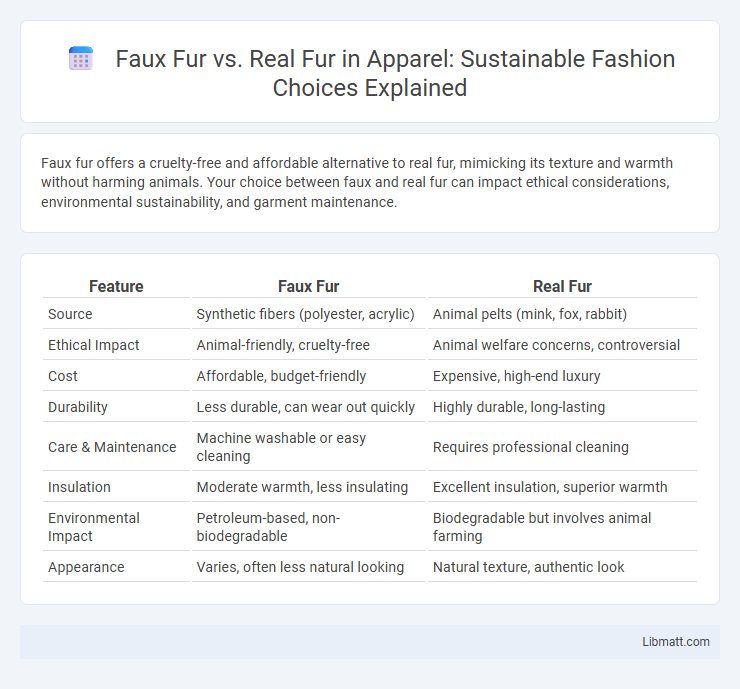Faux fur offers a cruelty-free and affordable alternative to real fur, mimicking its texture and warmth without harming animals. Your choice between faux and real fur can impact ethical considerations, environmental sustainability, and garment maintenance.
Table of Comparison
| Feature | Faux Fur | Real Fur |
|---|---|---|
| Source | Synthetic fibers (polyester, acrylic) | Animal pelts (mink, fox, rabbit) |
| Ethical Impact | Animal-friendly, cruelty-free | Animal welfare concerns, controversial |
| Cost | Affordable, budget-friendly | Expensive, high-end luxury |
| Durability | Less durable, can wear out quickly | Highly durable, long-lasting |
| Care & Maintenance | Machine washable or easy cleaning | Requires professional cleaning |
| Insulation | Moderate warmth, less insulating | Excellent insulation, superior warmth |
| Environmental Impact | Petroleum-based, non-biodegradable | Biodegradable but involves animal farming |
| Appearance | Varies, often less natural looking | Natural texture, authentic look |
Introduction to Faux Fur and Real Fur
Faux fur is a synthetic textile designed to replicate the appearance and texture of real animal fur, offering an ethical and cruelty-free alternative in fashion and home decor. Real fur comes from the pelts of animals such as mink, fox, and rabbit, prized for its natural warmth, softness, and durability. Choosing between faux fur and real fur impacts your environmental footprint, animal welfare considerations, and garment care requirements.
Historical Context of Fur in Fashion
Fur has been a symbol of wealth and status since ancient times, with real fur dominating fashion from prehistoric eras through the opulent styles of the Renaissance and Victorian periods. The 20th century saw a shift as ethical concerns and animal rights activism prompted designers to embrace faux fur as a cruelty-free alternative. Today, faux fur combines sustainability and style, reshaping the historical legacy of fur in contemporary fashion.
Ethical Considerations: Animal Welfare
Faux fur offers a cruelty-free alternative that eliminates harm to animals, aligning with ethical standards for animal welfare. Real fur involves the farming or trapping of animals, raising significant concerns about inhumane treatment and ecological impact. Choosing faux fur allows you to support compassionate fashion without contributing to animal suffering.
Environmental Impact: Production and Sustainability
Faux fur production relies heavily on synthetic fibers derived from petrochemicals, contributing to plastic pollution and non-biodegradable waste. Real fur farming involves animal agriculture, which generates significant greenhouse gas emissions, land degradation, and water consumption. Both options present sustainability challenges, but advancements in eco-friendly faux fur materials and ethical fur sourcing aim to reduce environmental impact.
Texture and Appearance: Similarities and Differences
Faux fur mimics the softness and visual appeal of real fur but often has a more uniform texture and consistent pattern due to synthetic fibers. Real fur features natural variations in hair length, density, and color, contributing to its unique plushness and depth that are difficult to replicate exactly. While both can appear luxurious, faux fur tends to have a shinier finish, whereas real fur offers a richer, warmer look with a natural undercoat.
Durability and Maintenance
Faux fur offers greater durability and easier maintenance compared to real fur, as it resists wear and tear without requiring special cleaning methods. Real fur, while naturally insulating and long-lasting if properly cared for, demands professional storage and delicate handling to prevent damage from moisture and pests. Choosing faux fur simplifies your routine with machine-washable options that retain their appearance over time.
Cost Comparison: Faux Fur vs Real Fur
Faux fur generally costs significantly less than real fur, with prices varying based on material quality and craftsmanship but remaining accessible to a wider audience. Real fur prices are typically higher due to the ethical sourcing, rarity, and the labor-intensive process involved in preparing genuine pelts. Consumers often weigh the affordability of faux fur against the luxury and durability associated with authentic fur garments.
Popular Brands and Market Trends
Popular brands like Stella McCartney and Shrimps lead the faux fur market, capitalizing on sustainability and ethical consumer demand. Real fur brands such as Fendi and Canada Goose face declining sales amid growing public scrutiny and regulatory restrictions. Market trends indicate a strong shift towards cruelty-free alternatives, with faux fur projected to grow at a CAGR of over 6% through 2028.
Consumer Preferences and Perceptions
Consumer preferences increasingly favor faux fur due to ethical concerns, environmental impact, and affordability compared to real fur. Studies show that younger demographics prefer faux fur for sustainability reasons, while some consumers perceive real fur as a luxury symbol despite controversy. Understanding your values and priorities can help you choose between the warmth and aesthetics of real fur or the cruelty-free appeal of faux options.
Future of Fur in Fashion Industry
The future of fur in the fashion industry increasingly favors faux fur due to growing ethical concerns and environmental awareness among consumers. Advances in textile technology enable high-quality faux fur that mimics real fur's texture and appearance, making it a sustainable and cruelty-free alternative. Your choice to embrace faux fur supports innovation and a shift towards more responsible fashion practices.
Faux fur vs real fur Infographic

 libmatt.com
libmatt.com